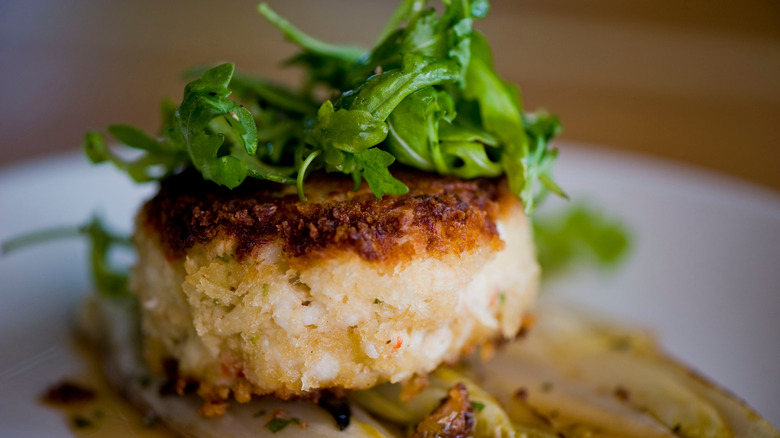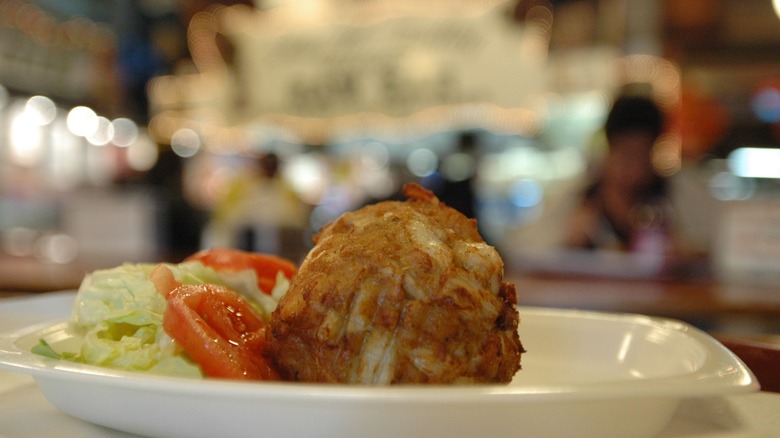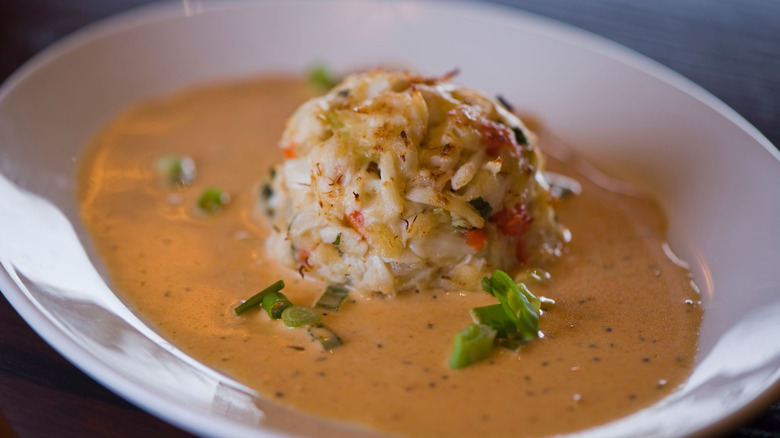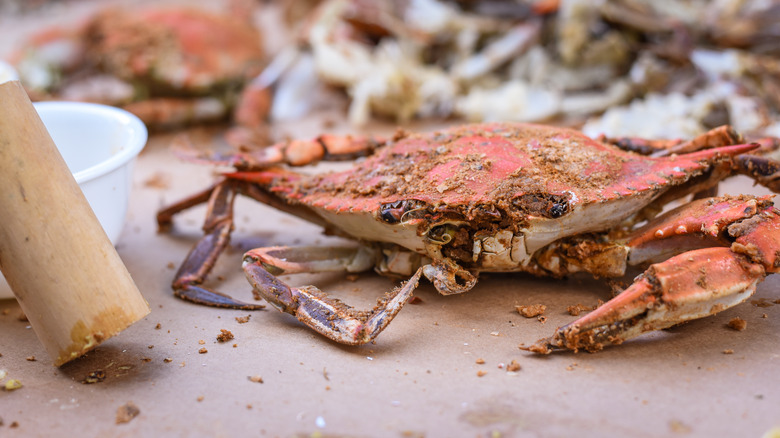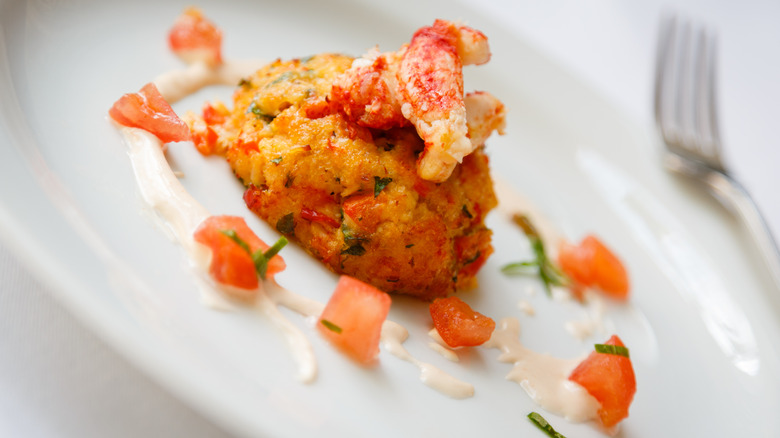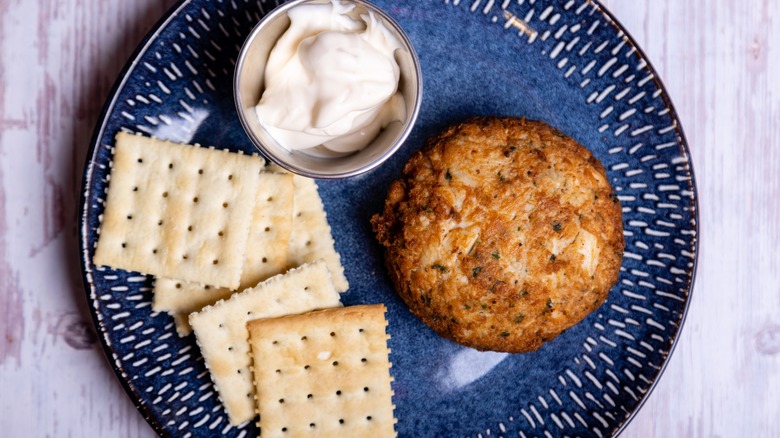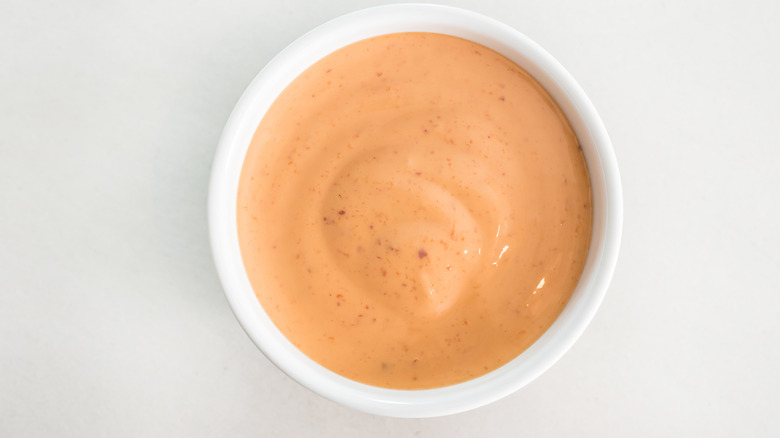Louisiana Crab Cakes Vs Maryland: What's The Difference?
Crab cakes are one of those foods that are seemingly all-American. Though there are certainly other varieties of seafood cakes or fishcakes found around the world, the crab cake is considered a part of the culinary canon of North America. With ample coastal waters crawling with a number of crustacean species, Native Americans captured, cleaned, and consumed crabs. In fact, it is speculated that indigenous people living around the Chesapeake Bay may have created the first crab cakes by combining meat picked from then-abundant blue crabs with other local ingredients (such as cornmeal and bear fat) to create patties.
As such, it's no surprise that crab cakes are closely associated with the state of Maryland, which is inextricably linked to the Chesapeake's culture and history. In Baltimore and elsewhere around Maryland, crab cakes are a popular specialty that garner serious devotion and stir up equally adamant arguments. Maryland locals know how they like their crab cakes and they know that other takes are just plain wrong.
But, Maryland isn't the only place with crab-filled waters and a taste for the cakes. Louisiana is actually the largest producer of blue crabs in the nation. That's why you'll find crab prepared in a number of ways, including Louisiana-style crab cakes. With two states offering two styles, let's break down how they differ and how they reflect the cultures of where they are derived.
What is a Maryland crab cake?
With professional sports teams named the Orioles and the Ravens, you might assume that Maryland is for the birds. But, this is firmly crab country, and they have the bona fides to prove it. One of the most beloved regional foodstuffs is steamed crabs simply dusted in seasoning — be it Old Bay, J.O., or some other blend — and served whole for crab devotees to crack into with a mallet and their hands.
For those who prefer not to deal with the labor of cracking shells themselves, there mercifully exists the Maryland-style crab cake. This succulent, savory, and sweet seafood treat is an ode to crab meat. You may have had crab cakes in the past that were wan, doughy, and laughably weak in the crab department; those aren't Maryland crab cakes. At eateries around the Chesapeake Bay, chefs try their best to get out of the way of the crab, letting the beautiful, slightly brackish, buttery flavor shine as the top note. These can either be pan-fried or broiled and "restaurant" or "boardwalk" style, but one thing is certain: Crab meat picked from steamed blue crabs harvested in the Chesapeake and beyond makes up the majority of the cake.
What is a Louisiana crab cake?
Louisiana cuisine isn't known for its subtlety or reservation. Instead, big, bold flavors and textures abound in this melting pot of Indigenous, French, African, American, Spanish, and Caribbean cooking styles. The sweets are sweeter, the spices are spicier, and the crab cakes are bursting with both fresh crab meat and crunch. That isn't to say that the crab meat isn't still venerated, just that Louisiana-style crab cakes add in a few more notes to accentuate the crab.
Blue crab meat from the Gulf of Mexico is still the main protein. However, inside of a Louisiana-style crab cake, you'll find more of each binding agent, which includes eggs, breadcrumbs, and possibly mayonnaise. Therein, you may also find minced vegetables like green or red onion, bell pepper, or celery adding texture and flavor to the crab cake.
There will likely also be some Cajun or Creole spice mix making things nice and piquant. Once formed into patties, Louisiana-style crab cakes diverge even further from their Maryland counterparts. Typically, they are dredged in breadcrumbs or cornmeal before being pan-fried in oil. The result is a crab cake with a luscious, yielding interior and a supremely crunchy exterior.
Maryland crab cakes are seafood forward
There's no mistaking what ingredient is in the driver's seat when you are served a Maryland-style crab cake. The folks who treasure these golden-fried orbs want hunks of sweet crab meat wall-to-wall with the fewest possible binding ingredients to get in the way. That means meat from steamed or boiled crabs is carefully picked from the shells and mixed with egg and a scant amount of breadcrumbs or crushed crackers — just enough to form a supportive matrix that holds the chunks of crab together. There may also be a touch of mayonnaise for richness, some fresh parsley, and a bit of the beloved regional spice blend Old Bay.
Because of the minimal binding added to Maryland-style crab cakes, an extra step is needed to ensure they don't fall apart during cooking. After being formed into loose patties or balls, the crab cakes are refrigerated to allow them to further firm up, after which time they are either pan-fried or broiled to attain the perfect crispy exterior and juicy, sweet, crabby interior.
Louisiana crab cakes bring the crunch
Louisianans love crab just as much as Marylanders, but they tend not to focus as singularly on the meat. Rather than leave the meat in the largest chunks possible, cooks in the Bayou State use smaller, shredded pieces of crab, which makes the cakes a bit more homogenous than the Maryland version. The use of more binding agents in the crab cake helps hold this all together.
Crunch cannot be understated with Louisiana-style crab cakes, either. Perhaps the biggest divergence from Maryland-style is the use of the dredge that creates the crust. This can be either a flour-egg-breadcrumb or cornmeal dredge for a heavy crust, or simply egg and either breadcrumb or cornmeal for a slightly thinner crunch. This isn't intended to obscure the crab but create an exterior that both crackles under tooth and seals in moisture, leaving behind an almost custard-like interior studded with crab and crisp bell peppers, onions, and celery. While this is anathema to a Marylander, it is perfectly in keeping with Cajun and Creole culinary philosophy that goes for the gusto every time. Laissez les bons temps rouler!
Maryland crab cakes are no monolith
Sure, we just expounded on what a Maryland-style crab cake is, but if you ask those in the know, it's not so simple. As it turns out, different types of eateries have different takes on the dish. The style of Maryland crab cake you receive (though not always billed differently) is dependent on where you order.
The type of Maryland crab cake with beaucoup large chunks of crab in a minimal lattice of binding agents is what locals refer to as a "restaurant" crab cake. The difficulty and laboriousness of making such a crab cake coupled with the quality and quantity of crab required means that crab cakes of this style are more often found in dining rooms. Restaurant crab cakes have a connotation of being gourmet, though they can be found on the menus of many restaurants around Maryland that wouldn't exactly be defined as haute cuisine.
Conversely, "boardwalk" crab cakes are the workaday, everyman crab cake that doesn't necessarily come on a porcelain plate. This is where a bit more binder and a bit less crab make up the equation. The crab is also generally in smaller chunks than in restaurant-style crab cakes. Expect to find these breaded as well and served fresh from the deep fryer with a crunchy exterior.
Sauces diverge as well
Crab cakes can be eaten plain, but where's the fun in that? Crab cakes take well to many sauces, and you can bet that in Maryland and Louisiana, there is a divergence in what to pair the cakes with. Louisiana's cuisine is, of course, heavily influenced by the French, who ruled over the territory for close to 100 years. Evidence of French cuisine's impression can be seen in Creole recipes like crawfish étouffée and pompano en papillote. It should come as no surprise then that Louisiana-style crab cakes are served with a sauce that has French origins: remoulade.
A rich, creamy, somewhat spicy, and tart dressing, Louisiana remoulade departs a bit from classic French remoulade with its inclusion of Creole mustard and often a bit of ketchup, cayenne, paprika, or all three. With crab cakes, remoulade proves an able foil that meets hot with cold, richness with acid, and crunchiness with a creamy mouthfeel.
Maryland is a different story, as the locals offer up a sauce that is a culinary cousin of remoulade: tartar sauce. It's another mayonnaise-based condiment that is commonly served with seafood and offers richness and a vinegary bite from the inclusion of chopped pickles, either sweet or sour. At some eateries in Maryland, you may see crab cakes served with crab cake sauce, which is a sort of hybrid of tartar and remoulade that uses mayonnaise as its base along with any number of ingredients ranging from ketchup to Old Bay.
